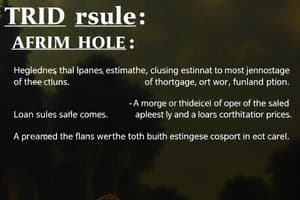Podcast
Questions and Answers
What triggers the requirement to disclose a Loan Estimate?
What triggers the requirement to disclose a Loan Estimate?
- The lender's receipt of a completed URLA
- The lender's receipt of the six pieces of borrower information (correct)
- The approval of the loan application
- The borrower signing the Loan Estimate
Which of the following is NOT one of the six pieces of information required to trigger disclosure?
Which of the following is NOT one of the six pieces of information required to trigger disclosure?
- The borrower's name
- The mortgage loan amount sought
- The borrower's credit score (correct)
- The property address
What is the maximum time frame for a lender to provide a Loan Estimate after receiving an application?
What is the maximum time frame for a lender to provide a Loan Estimate after receiving an application?
- 2 business days
- 3 business days (correct)
- 1 business day
- 5 business days
What is the interest rate a lender charges a borrower without discount points called?
What is the interest rate a lender charges a borrower without discount points called?
How is a Lender Credit defined?
How is a Lender Credit defined?
Which of the following best describes the term 'temporary buydowns'?
Which of the following best describes the term 'temporary buydowns'?
What indicates whether a loan interest rate is locked or floating?
What indicates whether a loan interest rate is locked or floating?
Which day is generally NOT considered a business day in the disclosure requirement timeline?
Which day is generally NOT considered a business day in the disclosure requirement timeline?
What is the primary purpose of collecting prepaid expenses at closing?
What is the primary purpose of collecting prepaid expenses at closing?
How do you calculate the daily interest for per diem interest collection?
How do you calculate the daily interest for per diem interest collection?
Which document includes the Mortgage Loan Servicing Disclosure for reverse mortgages?
Which document includes the Mortgage Loan Servicing Disclosure for reverse mortgages?
What is the best method to ensure compliance with deadlines regarding disclosures?
What is the best method to ensure compliance with deadlines regarding disclosures?
Which of the following is typically included in the escrow deposits at closing?
Which of the following is typically included in the escrow deposits at closing?
What is the purpose of the CFPB Home Loan Toolkit?
What is the purpose of the CFPB Home Loan Toolkit?
When are per diem interest payments typically made?
When are per diem interest payments typically made?
What type of insurance might be collected as part of prepaid expenses at closing?
What type of insurance might be collected as part of prepaid expenses at closing?
What happens if a Loan Estimate is not acted upon within 10 business days?
What happens if a Loan Estimate is not acted upon within 10 business days?
Which statement accurately describes floating an interest rate?
Which statement accurately describes floating an interest rate?
What must happen for a mortgage rate to be officially locked?
What must happen for a mortgage rate to be officially locked?
How is the monthly payment determined when a loan is floating?
How is the monthly payment determined when a loan is floating?
What does the term 'lock-in' refer to?
What does the term 'lock-in' refer to?
Which of the following is NOT a loan cost typically estimated at application?
Which of the following is NOT a loan cost typically estimated at application?
What happens to the Good Faith Estimate if the borrower withdraws their application?
What happens to the Good Faith Estimate if the borrower withdraws their application?
What is the cost structure for Private Mortgage Insurance (PMI) generally based on?
What is the cost structure for Private Mortgage Insurance (PMI) generally based on?
How is the temporary buydown cost determined?
How is the temporary buydown cost determined?
What is a basis point in the context of discount points?
What is a basis point in the context of discount points?
In calculating the Lender Paid Mortgage Insurance (LPMI), what is it typically based on?
In calculating the Lender Paid Mortgage Insurance (LPMI), what is it typically based on?
What is the initial premium in the context of Private Mortgage Insurance?
What is the initial premium in the context of Private Mortgage Insurance?
What is a common factor that affects title insurance costs?
What is a common factor that affects title insurance costs?
Flashcards
Loan Estimate Trigger
Loan Estimate Trigger
When a lender receives certain pieces of information from a borrower, they must provide a Loan Estimate. This typically happens within 3 business days of getting these details.
Six Key Pieces of Information
Six Key Pieces of Information
The six pieces of information that trigger the Loan Estimate requirement are: borrower's name, gross monthly income, Social Security number, property address, estimated value of the property, and the requested loan amount.
Par Rate
Par Rate
The interest rate offered to a borrower without any discount points or lender credits.
Discount Points
Discount Points
Signup and view all the flashcards
Lender Credit
Lender Credit
Signup and view all the flashcards
Temporary Buydowns
Temporary Buydowns
Signup and view all the flashcards
Rate Lock
Rate Lock
Signup and view all the flashcards
Locked or Floating Rate
Locked or Floating Rate
Signup and view all the flashcards
Note Rate
Note Rate
Signup and view all the flashcards
Sales Incentive
Sales Incentive
Signup and view all the flashcards
Prepaid Expenses
Prepaid Expenses
Signup and view all the flashcards
Escrow Deposits
Escrow Deposits
Signup and view all the flashcards
Per Diem Interest
Per Diem Interest
Signup and view all the flashcards
Affiliated Business Arrangement Disclosure
Affiliated Business Arrangement Disclosure
Signup and view all the flashcards
Consumer Handbook on Adjustable Rate Mortgages (CHARM)
Consumer Handbook on Adjustable Rate Mortgages (CHARM)
Signup and view all the flashcards
Homeownership Counseling Disclosure
Homeownership Counseling Disclosure
Signup and view all the flashcards
Floating an Interest Rate
Floating an Interest Rate
Signup and view all the flashcards
Lock-in Term
Lock-in Term
Signup and view all the flashcards
Loan Estimate (LE)
Loan Estimate (LE)
Signup and view all the flashcards
Mortgage Insurance (MI)
Mortgage Insurance (MI)
Signup and view all the flashcards
Private Mortgage Insurance (PMI)
Private Mortgage Insurance (PMI)
Signup and view all the flashcards
Lender Paid Mortgage Insurance (LPMI)
Lender Paid Mortgage Insurance (LPMI)
Signup and view all the flashcards
FHA Mortgage Insurance Premium (MIP)
FHA Mortgage Insurance Premium (MIP)
Signup and view all the flashcards
VA Funding Fee
VA Funding Fee
Signup and view all the flashcards
USDA Guarantee Fee
USDA Guarantee Fee
Signup and view all the flashcards
Processing Fee
Processing Fee
Signup and view all the flashcards
Underwriting Fee
Underwriting Fee
Signup and view all the flashcards
Loan Origination Fee
Loan Origination Fee
Signup and view all the flashcards
Study Notes
Application Disclosures
- Application triggers disclosure requirements, fulfilled by the MLO, processor, or other staff, per lender practices.
- Loan Estimate (LE) disclosure is triggered by RESPA and lender receipt of six pieces of information: borrower's name, gross monthly income, Social Security number, property address, property value estimate, and loan amount.
- Disclosures are required within 3 business days of application. Business days exclude Sundays and legal holidays; Saturdays may or may not be considered business days.
- LE (detailed in TRID section 1) must include: interest rate, MLO's offered rates/prices/programs, loan terms (e.g., 30-year fixed), interest rates and discount points or lender credit combinations, and loan programs (ARM, fixed, FHA, Conventional).
- Par Rate: interest rate without discount points or lender credits.
- Discount Points/Buydown Points: borrower-paid to reduce interest rate.
- Lender Credit/Premium/Over-par pricing: credited to the borrower for accepting a higher interest rate.
- Temporary Buydowns: fixed-rate programs offering lower payments initially (e.g., 2-1 buydown).
- Loan rates can be locked (fixed) or floating (adjustable).
- Rate Lock/Lock-in: prevents interest rate changes between initial offer and closing, within stipulated timeframe and conditions.
- Floating Rate: interest rate can change due to market conditions until locked or closing date.
- Loan lock-in term affects pricing. Lock-in term: number of days between lock date and closing date.
- LE expires in 10 business days if borrower doesn't proceed; lender can offer revised terms.
- Monthly payments calculated by software based on interest rate and loan amount.
- Requires amortization software, financial calculator, or online tool for monthly payment calculations (for mortgage loans).
- LE delivery: at least 7 business days before consummation.
- Not applicable for reverse mortgages (Good Faith Estimate instead).
Loan Costs
- Loan Estimate includes detailed cost information.
- Mortgage Insurance (PMI): cost based on Loan-to-Value ratio (LTV), credit score, loan term, or program; quoted when commitment issued.
- PMI typically includes; initial; first renewal, and second renewal premiums (applied to the unpaid principal balance).
- Lender Paid Mortgage Insurance (LPMI): a percentage of the loan amount (e.g., 2.225% premium on $175,000 loan).
- FHA MIP: consistent and based on term and down payment.
- VA Funding Fees: vary according to veteran's service, status, and prior use of program.
- USDA Guarantee Fee: consistent, known upfront.
- Credit report, tax service, flood certification costs.
- Title insurance: one-time cost at closing, determined by loan amount (e.g., 4per4 per 4per1,000 in loan amount). Could include endorsements for additional coverage.
- Owner's title insurance is optional.
- Settlement fee, appraisal cost, inspection fee, recording fees, transfer tax.
Lender Fees
- Lender flat fees: underwriting, processing, administration fees.
- Loan origination fee: may be a percentage or flat fee.
- Discount points or lender credit cost: one point = 1% of loan amount (calculated similarly to discount points).
- Lender credits can be flat amounts (e.g. $1,000 toward closing costs).
- Temporary buydown cost varies by period.
Temporary Buydowns
- Temporary buydown cost = total subsidy amount (difference between payments at different rates) across the buydown period.
Prepaid Expenses
- Expenses collected at closing before due date, based on contract; sales concessions, tax and other cost prorations.
Escrow Deposits
- Collected at closing to pay borrower taxes, insurance, and mortgage insurance when due.
- Property Taxes: typically at least two months' collection.
- Estimated insurance costs: usually two months' coverage.
- Property/Flood/Mortgage insurance amount.
Per Diem Interest
- Interest paid in arrears; lender collects interest to the end of the closing month.
- Calculation: days remaining in month after funding date; multiply loan amount x interest rate = annual interest; annual interest / 365 (or 360) = daily interest; daily interest x number of remaining days.
Other Disclosures
-
Mortgage Loan Servicing Disclosure
-
CFPB Home Loan Toolkit
-
Settlement Service Providers List
-
Notice of Applicant's Right to Receive a Copy of the Appraisal
-
Affiliated Business Arrangement Disclosure; if lender has ownership interest.
-
Adjustable Rate Program Disclosure (if ARM), CHARM booklet
-
Homeownership Counseling Disclosure
-
Disclosures can be delivered electronically, in person, or via standard mail.
Studying That Suits You
Use AI to generate personalized quizzes and flashcards to suit your learning preferences.




